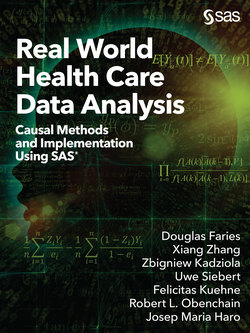Читать книгу Real World Health Care Data Analysis - Uwe Siebert - Страница 5
На сайте Литреса книга снята с продажи.
ОглавлениеAbout the Book
What Does This Book Cover?
In 2010 we produced a book, Analysis of Observational Health Care Data Using SAS®, to bring together in a single place many of the best practices for real world and observational data research. A focus of that effort was to make the implementation of best practice analyses feasible by providing SAS Code with example applications. However, since that time, there have been improvements in analytic methods, coalescing of thoughts on best practices, and significant upgrades in SAS procedures targeted for real world research, such as the PSMATCH and CAUSALTRT procedures. In addition, the growing demand for real world evidence and interest in improving the quality of real world evidence to the level required for regulatory decision making has necessitated updating the prior work.
This new book has the same general objective as the 2010 text – to bring together best practices in a single location and to provide SAS codes and examples to make quality analyses both easy and efficient. The main focus of this book is on causal inference methods to produce valid comparisons of outcomes between intervention groups using non-randomized data. Our goal is to provide a useful reference to help clinicians, epidemiologists, health outcome scientists, statisticians, data scientists, and so on, to turn real world data into credible and reliable real world evidence.
The opening chapters of the book present an introduction of basic causal inference concepts and summarize the literature regarding best practices for comparative analysis of observational data. The next portion of the text provides detailed best practices, SAS code and examples for propensity score estimation, and traditional propensity score-based methods of matching, stratification, and weighting. In addition to standard implementation, we present recent upgrades including automated modeling methods for propensity score estimation, optimal and full optimal matching procedures, local control stratification, overlap weighting, new algorithms that generate weights that produce exact balance between groups on means and variances, methods that extend matching and weighting analyses to situations comparison more than two treatment groups, and a model averaging approach to let the data drive the selection of the best analysis for your specific scenario. Two chapters of the book focus on longitudinal observational data. This includes an application of marginal structural modeling to produce causal treatment effect estimates in longitudinal data with treatment switching and time varying confounding and a target trial replicates analysis to assess dynamic treatment regimes. In the final section of the book, we present analyses for emerging topics: reweighting methods to generalize RCT evidence to real world populations, sensitivity analyses and best practice flowcharts to quantitatively assess the potential impact of unmeasured confounding, and an introduction to using real world data and machine learning algorithms to identify treatment choices to optimize individual patient outcomes.
Is This Book for You?
Our intended audience includes researchers who design, analyze (plan and write analysis code), and interpret real world health care research based on real world and observational data and pragmatic trials. The intended audience would likely be from industry, academia, and health care decision-making bodies, including the following job titles: statistician, statistical analyst, data scientist, epidemiologist, health outcomes researcher, medical researcher, health care administrator, analyst, economist, professor, graduate student, post-doc, and survey researcher.
The audience will need to have at least an intermediate level of SAS and statistical experience. Our materials are not intended for novice users of SAS, and readers will be expected to have basic skills in data handling and analysis. However, readers will not need to be expert SAS programmers as many of our methods use standard SAS/STAT procedures and guidance is provided on the use of our SAS code.
What Should You Know about the Examples?
Almost every chapter in this book includes examples with SAS code that the reader can follow to gain hands-on experience with these causal inference analyses using SAS.
Software Used to Develop the Book’s Content
SAS 9.4 was used in the development of this book.
Example Code and Data
Each of the examples is accompanied by a description of the methodology, output from running the SAS code, and a brief interpretation of the results. All examples use one of two simulated data sets, which are available for the readers to access. While not actual patient data, these data sets are based on two large prospective observational studies and designed to retain the analytical challenges that researchers face with real world data.
You can access the example code and data for this book by linking to its author page at https://support.sas.com/authors.
Acknowledgments
We would like to thank several individuals whose reviews, advice, and discussions on methodology and data issues were critical in helping us produce this book. This includes Eloise Kaizar (Ohio State University) and multiple colleagues at Eli Lilly & Company: Ilya Lipkovich, Anthony Zagar, Xuanyao He, Mingyang Shan and Rebecca Robinson. Also, we would especially like to thank three individuals whose work helped validate many of the programs in the book: Andy Dang (Eli Lilly), Mattie Baljet, and Marcel Hoevenaars (Blue Gum Data Analysis). Without their efforts this work would not be possible.
We Want to Hear from You
SAS Press books are written by SAS Users for SAS Users. We welcome your participation in their development and your feedback on SAS Press books that you are using. Please visit sas.com/books to do the following:
● Sign up to review a book
● Recommend a topic
● Request information on how to become a SAS Press author
● Provide feedback on a book
Do you have questions about a SAS Press book that you are reading? Contact the author through saspress@sas.com or https://support.sas.com/author_feedback.
SAS has many resources to help you find answers and expand your knowledge. If you need additional help, see our list of resources: sas.com/books.
